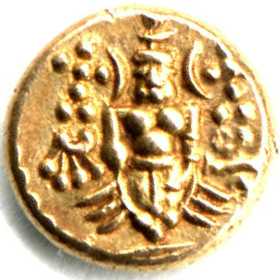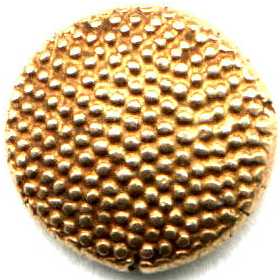| SPECIFICATIONS | |
| Denomination | One Pagoda |
| Legal | Gold Au.71 |
| Metal XRF | Gold Au0.649 |
| Alloy | Ag%Cu 0.14 |
| Type | Stuck |
| Diameter | 11.6 mm |
| Thickness | 3.8 mm |
| Weight Legal | 3.406 gms |
| Weight | 3.38 gms |
| Shape | Round |
| Edge | Plain |
| DieAxis | 0° |


|

|

| ||||||||||||||||||||||||||
| Scholten 1259 KM Tuticorin #49 ; Mitchiner #1594c | ||||||||||||||||||||||||||||
Obverse : Degenerated Vishnu standing, without lazy J to right at 3 O'clock.
Reverse : Granulated. convex
According to available Minting records abstracted in
Codrington (pages 141-142)
Ignored the weird fractions listed by Codrington which however
probably reflects that the number of pagodas minted has been computed
from the issued value.
| 1764 | 0.800 | 29557 | Tuticorin |
| 1785 | 0.769 | 101756 | Colombo |
| 1787-1794 | 0.769 | 641567 | Tuticorin |
| 1783 | 0.708 | 34904 | Colombo |
| 1788 | 0.625 | 7106 | Tuticorin |
They were also struck by the English and Dutch East India Companies at Pulicat, Negapatnam and Madras. Similer but with specific issue symbols were struck at Pondicherry, Tranquebar and Arcot.
Scholten says For the payment of debt to France arising out of the war with England in 1783 a parcel of gold coins formerly current on the Coast of Malabar, together with "Persian and Hindustan gold Mohrs" was reminted into more than 34900 Porto Novo Pagodas of 17 carats or 0.708.
According to Krause these latest issues from Tuticorin and Colombo were without the lazy J. The source of this information is unknown.
This pagoda is of Tuticorin style. I need to measure purity of gold, to see if it happens to be from Colombo Mint.. The pagoda of standard weight shown above is larger in both diameter and thickness than the Negapatam pagoda which implies a lower density and therefore debased gold.
Text from
* Ceylon Coins and Currency By H. W. Codrington. Colombo 1924
Page 172 Chapter XIII Miscellaneous: VI - Pagodas and Fanams.
The coin was scanned at 600dpi and the images are displayed at 500dpi.
It was obtained in 2002 March from a seller in Switzerland.